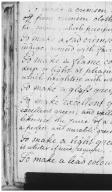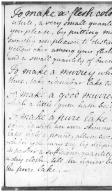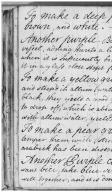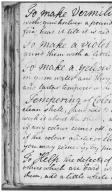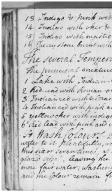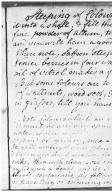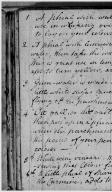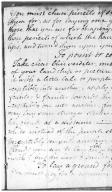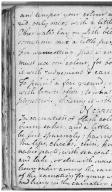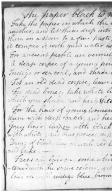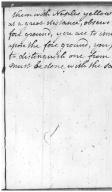[ The Seven Painting Colours in General ] Thomas Wright
Date: The notebook is dated by the archive, 1769-1773. | 1769/01/01 to 1773/12/31
Source:
Diary of Thomas Wright
Institution: Prince Edward Island Public Archives
| Source Origin: Thomas Wright Fonds
| Sublocation: Diary of Thomas Wright
| Reference: CA PCA Accession 3241
These instructions are excerpted in part from John Barrow's Dictionarium Polygraphicum: or, the Whole Body of Arts Regularly Digested (London, 1735) and in part from Godfrey Smith's The Laboratory, or School of Arts (London, 1738). Barrow's work draws on William Salmon's Polygraphice, or the Arts of Drawing, Engraving, Etching, Limning, Painting,Washing, Varnishing, Gilding, Colouring, Dying, Beautifying, and Perfuming in Four Books, printed first in 1672 in London and several more times until 1701.
The seven painting Colours in general
1 The chief whites are Spodium, Ceruss, white lead, Spanish white
Egg-shells burnt, Flake white, Mussel Silver
The Spanish white is thus made:
Take fine chalk six ounces, allum two ounces, grind them together in
fair water, till it be like pap, roll it up into balls, which dry
leisurely, then put them into the fire till they are red hot, take them
out & let them cool.
This is the best white of all to garnish with, being ground with weak
gum water.--
2 The Chief Blacks are these: harts-horn burnt, Ivory burnt, lamp-black
Charcoal, Sea coal, verditer burnt, mummy burnt
3 The Chief Reds are these; Carmine, Vermilion, red lead lake" class="emmr-anno">lake">Indian lake,
Native cinnabar, red oaker, yellow oaker burnt, Indian red.
4 The Chief Greens are these; green bice, green pink, Verdegrease, Verditer,
sap-green, pink mixt with bice and Terra verde
5 The Chief yellows are these, orpimint, masticote deep and light, Saffron
pink yellow, dark & light, oker de luce, English oaker, Roman oaker, gall stone
6 The Chief Browns are these; umber, Spanish-brown, Colens earth, gall-stone
rust of iron, mummy.
7 The Chief Blues are these; ultramarine, Indigo, smalt, blue-bice ^Latinios, Prusian blue, Blue lake
This is to be noted, that of the Colours before named, Vermilion, Verdigris
Orpiment, and some others are too Coarse & gritty to be used in water Colour
unless they be purified and prepar’d.
Add Turnsole, litmose blue, roset, brasil, logwood and saffron are more fit
for washing prints than curious limning.--
The principal colours used by painters are red & white lead or ceruss, yellow
and red oakers; several kinds of Earth, as umber, orpimint, lamp-black;
burnt Ivory, black lead, cinnabar or vermilion; gamboge, lacca, blue and
green ashes, verdegrease, bistre, bice, smalt, carmine, ultramarine
Of these colours some are used tempered with gum water, some ground with oil
others only in fresco, and others for miniature.--
painters reduce all the Colours they use under then two classes of Dark & light
Colours.-- Dark colours are black, and all others that are obscure and
earthy, as umber, bistre &c.--
under light Colours are comprehended white, and all those that approach [near?]
it.-- Painters also distinguish Colours into simple & mineral: under
simple Colours they rank all those which are extracted from Vegetables and which
will not bare the fire, as the yellow, made of Saffron, French bernis, lacca, and
other tinctures extracted from flowers, used by limners, illuminers &c--
The mineral colours are those which are drawn from metals &c and that are
able to bear the fire: used by enamellers--
Colours are either Changeable or permanent, Changeable colours are
such as depend on the situation of the object with respect to the Eye--
as that of a Pigeon’s neck, taffeta’s &c.--
Permanent colours are not exhibited by refraction, but by reflection.--
M. Mariotte observes, that there are two different gradations or series of
Colours from white to black, the one white, yellow, red & black, and the other
white, blue, violet, and black.--
Of Preparing Colours
Colours according to their nature, have each a particular way of prepar.
viz. by grinding, washing, or steeping.
The Chief Colours to be ground are these; white lead, ceruss, cinnabar, lake, oker yellow
and brown, pink, indigo, umber, colens earth, Spanish brown, ivory black, cherry stone
black, lamp black, [ ] red, lake" class="emmr-anno">lake">Indian lake.--
The Chief colours [to be washed?] are; red lead, masticote, green bice, ceder green, ultra
marine, blue bice [ ] verditer.
The Chief colours [to be steep'd] are; sap green, saffron, turnsole, stone blue, Venice
berries [ ] Gamboge, [. ] yellow, to which you must add a little allum, Blue lake and
La[ ].
The Method of Grinding Colours
Take the Colour you would grind, and scrape off from it all the filth;
then lay it upon the stone, and with the muller, bruise it a little; then
put to it a little spring water, and grind all together very well, till the
Colour is very fine; which done, pour it out in certain hollows or furrows
[C?]ut in chalk-stone, and there let it lie till it is dry, which preserve in paper or
glasses. -- Take care in grinding your colours not to put too much
water to them upon the stone, for they ought to be ground pretty thick like
pulp or pap, and they ought not to be left too moist, but thick & Clammy.
If after your colour is dry in the shell, you can rub it off with your
fingers, it must be better bound with gum; and if there be too much gum,
it will shine, and be apt to crackle off after it is used.--
Of mixt and compound Colours
An ash colour or gray is made by mixing white and lamp-black, or white
with sinaper; indigo and black make an ash colour
To make an azure or blue. Mix the azure with glue water and not
with gum water --
A bay colour – Mingle vermilion with a little spanish brown and
black.--
A bright crimson. Mix tincture of brazile with a little ceruss ground with
fair water.--
To make a crimson lake. It is usually made of the flocks shorn
off from crimson cloth, by a lye made of salt-petre, which extracts
the colour; which precipitate, edulcorate, and dry in the sun, or in a stove.--
To make sad crimson. Mix the aforesaid light crimson, with a little
indigo, ground with fair water:
To make a flame colour. It is made of vermilion and orpiment, mixt
deep or light at pleasure: or thus, take red lead, and mix it with masticote
which heighten with white.
To make a glass grey. Mingle ceruss with a little azure.
To make excellent good greens. The liver of a lamprey makes an
excellent green; and yellow laid upon blue will change into green; so
likewise the juice of a blue flower de luce, mixt with gum water, will be
a perfect and durable green or blue, according as it is used.--
To make a light green. It is made of pink or smalt with white, to make
it whiter if need require.
To make a lead colour. It is made of white, mixed with indigo.
To make a flesh colour, Mix a little lake and red lead with
white, a very small quantity of each, you may make it as light or as red as
you please, by putting more or less white in it. If you would have a
swarthy complexion to distinguish a mans flesh from a woman’s, put a little
yellow oker among your flesh colour; and for your shadow, put a little more lake,
and a small quantity of burnt umber.
To make a murrey which is compos’d of purple and white; it is made
thus. take cinnabar lake two ounces, white lead one ounce and grind them together.
To make a good murrey. Temper roset with a little rose water, in
which a little gum hath been dissolved, and it will be good but not better, than the [first?]
To make a pure lake. Take urine ten pounds, boil it in a kettle, and
skim it with an iron skimmer, till it comes to eight pounds; to which add gum
lake half a pound, allum two ounces and a half; boil all till it is well colourd,
which you may try by dipping a piece of linen cloth in it; then add sweet allum
in powder a sufficient quantity; strain it and let it stand; strain it again thorough
a dry cloth, till the liquor be clear; that which remains in the cloth or bag is
the pure lake.--
To make a deep purple. This is made of indigo, Spanish
brown, and white.--
Another purple. Boil log-wood in vinegar and beer in a glazed earthen
vessel, adding thereto a little allum, till you taste it to be strong on your tongue
when it is sufficiently boil'd, strain out the liquor through a cloth, and keep
it in a glass close stopt for use.--
To make a yellow grown or purple. Buck thorn berries gather’d green
and steep’d in allum water, yeild a good yellow; but being thorough ripe &
black, they yeild a good green; and lastly, being gather’d when they are ready
to drop off, which is about the middle or end of November, their juice mix’d
with allum water, yields a good purple colour.--
To make a pear green. Take white Tarter and verdegrease;
temper them with strong white wine vinegar, in which a little gum
arabick has been dissolved.
Another Purple colour. Mix blue bice and lake together, or if you
want bice, lake blue verditer (but that is not altogether so good) mix them
well together, and it is done. If you want lake, you may instead thereof use
thick red ink, which will do as well as lake in washing.
To make Cloud colours. You may sometimes take blue
verditer, sometimes light masticote shadowed with blue verditer
or lake and white, or red ink and white shadowed with blue verdi ^ter
To make a red colour. Take the roots of the lesser bugloss, viz.--
alkanet, and beat them, and strain out the juice and mix it with allum water.
To make a Scarlet colour. It is made of read lead, lake and vermilion
yet vermilion in this case is not very useful.
To make a pure purple colour. Take fine brimstone an ounce and
a half, quicksilver, sal armoniac. Jupiter, of each one ounce,
pulverize the salt and brimstone, and make an amalgama with the
quicksilver and tin, mix all together, which put into a great glass gourd;
make under it an ordinary fire, and keep it in a constant heat for the space
of six hours.--
A Saffron colour, is made of Saffron alone by infusion.--
To make Vermilion. Take brimstone in powder four ounces, mix it
with quicksilver a pound, put it into a crucible well luted, and upon a charcoal
fire heat it till it is red hot, their lake is off and let it cool.
To make a violet colour. Take a little indigo and tincture of brasile
grind them with a little ceruss.--
To make a yellow. Take the yellow chives in white lilies steep them
in gum water and they will make a perfect yellow; the same from Saffron
And tartar tempered with gum water.
Tempering of Colours. Take a little of any Colour, and put it into a
clean shell, and add to it a few drops of gum water, and with your finger
work it about the shells, and let it dry, and when dry, touch it with your finger
if any colour comes off, you must add stronger gum water, but being dry
if the colour glister or shine, it is a sign there is too much gum water which
you may remedy by putting in fair water.--
To Help the defects of Colours. Some colours as lake, umber and
others which are hard will crack; when they are dry in this case in tempering
them, add a little white sugar candy in very fine powder; which mix
with the colour and fair water in the shell, till the sugarcandy is disolv[ed].
These Colours, umber, Spanish brown, colen-earth, cherry stone
And Ivory black, are to be burnt before they are ground or wash'd.
To Burn or Calcine colours. This is to be done in a crucible, cover
-ing the mouth of it with Clay, and setting it in a hot fire, till you are
sure it is red hot through, which done being cold, wash or grind them
as before directed.
To prepare Shadows for Colours. White is shaded with black,
and contrary-wise, yellow with umber and the okers, Vermilion with
lake, blue bice with indigo, black-coal with roset, &c.
The several Temperatures for colouring and Shadowing History
They are twenty in number, viz.
1 Sea coal mixt with lake. 7 Verditer burnt with red lead & white
2 umber mixt with masticote 8 Ultramarine with lake.
3 yellow-oker burnt with white 9 Ultramarine with red lead
4 Umber with ultramarine 10 Ultramarine with white
5 Yellow with umber 11 Indigo with white
6 Umber with lake 12 Indigo and lake with white
13 Indigo & pink with white. 17 Burnt Ivory with lake.
14 Indigo with oker & white 18 Indigo and pink with best rust of Iron
15 Indigo with masticote & white 19 Lake & rust of iron with light pink
16 Cherry stone bunt with white and red-lead 20 Rust of iron & lake for the deeper shadows
The several Temperatures or mixtures for Shadowing Heads after the Life
The principal mixtures are twelve in number
1 Lake with Indian-red 7 Red lead with Roman oker & indigo
2 Red-lead with Roman-oker 8 Red lead with pink, yellow oker & lake
3 Indian red with ultramarine 9 Indigo lake and Roman oker with white
4 Indian red with pink and gallstone 10 Indigo pink and Roman oker with Indian red
5 yellow oker with indigo 11 Red led with umber, masticote and pink
6 Red lead with pink and indigo 12 pink with Roman oker
To Wash Colours. Put the colours into a glazed vessel, and put fair
water to it plentifully, wash it well, and decant (after a while) the water; do
this six or seven times; at last put the water (being just troubled) into another
glaz’d vessel, leaving the dregs at the bottom; then into this second vessel put
more fair water, washing it as before, till the water (being settled) be clear
and the colour remain fine at the bottom.--
Steeping of Colours. Take a quantity of the Colour, and put
it into a shell, & fill the shell with fair water, to which add some
fine powder of allum, to raise the Colour, let it thus steep a Day & Night
and you will have a good Colour--
Where note, Saffron steep'd in vinegar gives a good colour, and the
Venice berries in fair water and a little allum, or a drop or two of
oil of vitrol makes a fair yellow.--
But some Colours are to be boil’d, as brasile, logwood, turnsole, rinds
of wallnuts, wood soot, &c these when boil’d are to be kept close stopp’d
in glasses, till you have occasion to use them.
Note. Colours which are very dry, require a stronger gum water; in [them?]
it must be used very sparingly. Some Sugar Candy dissolved in [thing?]
water is very good [ ] If your Colours will not stick on the paper
or paint be [greasy?], mix a very little Ear wax, or a little drop of fish or
ox gall amongst your Colours.--You may dry your fish or gall, and dilute
it [ ] you have occasion for it, with a little Brandy. – If your paper or print
sinks, then with clean [size?] and a sponge wipe it over, after you have fastened the edge
round upon a board, and let it dry. – You should be provided always with
phials, containing the following liquids, which are very necessary, and useful
in painting or colouring with water colours.--
1 A phial with water, in which allum had been dissolved, this you
use in whiping over the table, parchment, or paper, before you begin
to lay on your colours; it will cause them to lay smooth, and with a greater Luster.
2 A phial with lime-water; you dissolve or slacken some quick lime with fair
water, then take the water from off the settled lime, and put it up for servic,
This is great use in tempering of sap green and litmus, which colours being
apt to ]turn yellow, are preserved thereby.—
3 Gum-water is made of gum-arabic dissolved in fair water; if you add a
little white sugar candy to it, that will keep the colours from cracking and
flying off the parchment or paper.—
4 Ox gall, or the gall of eels, boil’d up in a little water, and [ ]
then put up in a phial; this is of great use in painting of water colours,
when the parchment or paper happens to be greasy, by only couching
the point of your pencil to touch it therewith, and to temper it with your
colour—
5th White wine vinegar; this is of use in grinding of distilled verdigrease, as pre
serving that Colour from changing upon the yellow.—
6th A little phial of spirit of hartshorn, a little drop whereof mixed among
the Carmine, adds to the beauty thereof.--
You must chuse pencils of several sizes, agreeable to the work you are to use
them for; as for laying on a ground, a sky, or clouds, choose a larger size than
those that you use for drapery, trees, &c. wherein you must follow own [? ]
those pencils of which the hairs, after you wetted them between your
lips, and turn’d them upon your hand, keep close together are the best:--
To paint or colour a clear sky
Take clear blue verditer, mixed with a little white; with this begin at the top
of your landskip or picture, and having laid on the blue for some space, break
it with a little lake or purple, working it with a clear pencil, one colour imper
-ceptibly into another, apply more white and masticote in order to make it--
fainter & fainter towards the horizon working all the white the colours imper
-ceptibly one into another from the horizon to the blue sky; after which, you
may lay some stronger strokes of purple over the light, is as to make them appear
like clouds at a distance – For a fiery red sky use red lead, and a little
white instead of the purple streaks or clouds, working them according to art, im
perceptibly one with another. –
Clouds you are to lay on ^with white & black, sometime mix a little purple there
-with: but the best & surest direction you can have is from nature herself
To lay a ground for walls of chambers, halls &c.
You must use for a common wall which is of reddish hue, brown, red, and white.
and temper your colour according as it is old or new; shade it with brown or
red, only mixt with a little bistre or soot.—
Other walls lay on with black & white, and shade it with the same colours;
sometime mix a little purple with it, and then you shade it with black & lake
For wanscotting that is embellished with carved mouldings, and figures, you
must use one colour, for both the plain & the carved work, shading & heightening
it with judgement & care.—
To paint a foreground, in imitation of sand or clay, lay on the darker parts
with brown oker; to what is in their distance, add a little white, & so on in
preposition, shading it with brown oaker, and the strong shades with soot.—
Of carnation or flesh colour.—
In carnation or flesh colour, use for young women & children flake white
burnt oaker and a little vermillion; some add a little lake, but that must
be but sparingly; having laid in the colour for the carnation you shade
the lips, cheeks, chin, knees, and toes, with fine lake & vermillion, and the
naked parts, with sea coal and a little lake, or brown red, or with brown oaker
and lake, or else with indian ink or lake; for a brownish complexion, mix a little
brown oaker among the carnation colour—Some artists lay the dead colouring
of the carnation for young women on with white; they shade it with paper black
and bring in the carnation colour where it is required.—
The paper black is made in the following manner—
Take the paper in which the leaves of gold have lain, burn them quick one after
another, and let them drop into a bason of clean water, then take them out and grind
them on a stone to a fine paste, form it into little tents, and let it dry; when you use
it temper it with gum water as you see meett.—
For ancient people use vermillion, brown oaker and white, shade it with bistre & lake
A deap corpse of a young person, paint with flake white; brown oaker, and a little
Indigo or sea coal, and shade it with bistre or sea-coal.—
For an old dead corpse, leave out the indigo, but shade it as before.
For dead bones, take white lead, mixed with a little bistre or chimney soot with
which you shade and heighten with white lead.—
For the hair of young women and children lay them with light oaker, shade
them with deep oaker, and heighten them with mastick & white.__
Grey hair, lay on with black & white shade them with black, and heighten them
with white, and thus proceed in painting any other color’d hair:--
Drops of blood, lay on with red lead, shade it behind, where the light falls, with carmine
and lake.—
Trees are laid in, some white, black, and bistre, shaded with brown oaker, and heigh
-tened with the same colour, with more white in it. Those that stand at a distance, are
laid on with indigo blue, brown oaker & white, and shaded with indigo and brown oaker
Those that are farther distant lay on faint, and shadow them but slightly;
which order you must observe in colouring of ships, houses, and other buildings—
In thatched houses, paint the thatch or straw, when new with pink" class="emmr-anno">pink">dutch pink, and
shade it with brown oaker, and to heighten the straw, use masticot & white:
Old straw lay on with brown oaker, sometimes mixed with black & white, heigh
-ten the straw with brown oaker & white.—In colouring cities, castles or
ruins you must observe nature for no rules can well be given; however to give
a little light to a young practitioner, it must be observed that those houses which
be nearest the fore ground are colour’d with vermillion, white, and a little brown
oaker shading it with that & some bistre; the heightenings are done with more
vermillion and more white.—
Houses further distant are laid on with lake, and a little blue & white, shaded
with blue & lake and heightened with adding more white.—
Such buildings as lie still further, are laid in with a faint purple, and a little
blue, shaded softly with blue, and heightened with white; and the further they
are off the fainter and slighter must be your colour.—
Flames and smoke are laid on with a pale yellow; shade the smoke with
paper black, or soot; the flames shade with red lead or vermillion, and heighten
them with Naples yellow. – In colouring of Rocks hills &c that are
at a great distance, observe the same rule. – Such as lay nearer the
foreground, you are to imitate according to nature. Trees that are
upon the foreground, you pain with several sorts of greens, the better
to distinguish one from the other; such as are on distant hills,
must be done with the same colour as the Hills.—
Download: Transcription | Images




